Tony Garcia is a playwright, director, and executive artistic director of Su Teatro in Denver, Colorado. He grew up in the Chicano protest movement of the 1970s, which has influenced his career. Garcia has spent the last fifty years advocating for equitable representation of cultural work and organizations, mentoring young artists, contributing to civic change, and shining a light on Colorado’s Chicano community. Claudia de Vasco is an arts leader and theatre creative, currently based in San Antonio, Texas. The two exchanged their experiences learning about the Chicano movement and how it influenced their involvement in the theatre.
At the time of this interview in January 2023, Claudia de Vasco served as the executive artistic director of the Public Theater of San Antonio. She resigned from the position in April 2023.
Projections and Reflections on Chicano Theatre
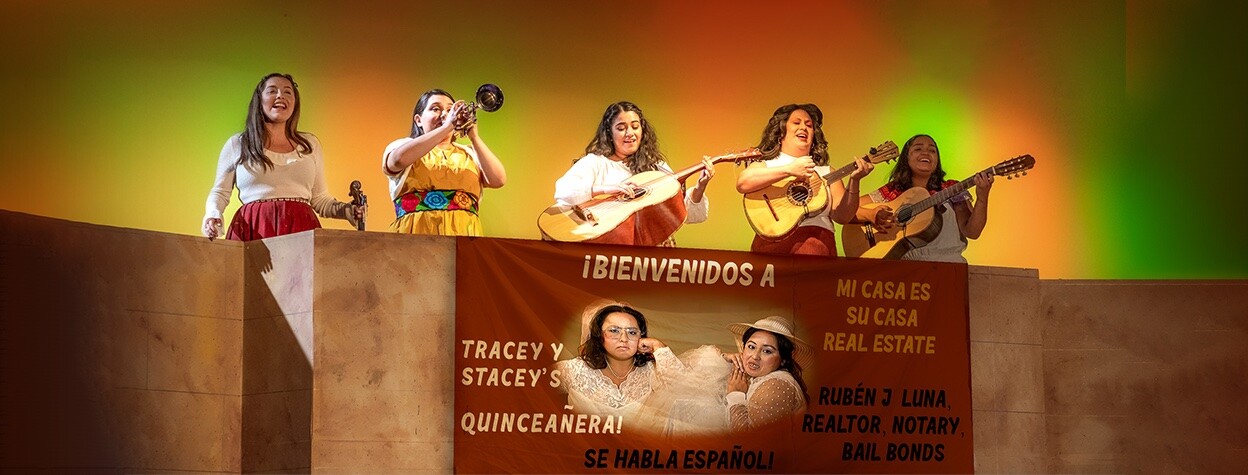
Andrea Daniela, Amy Mireles de la Rosa, Bianka Nicole Torres, Crystal M. Bratton, and Giselle Galindo in American Mariachi by José Cruz Gonzalez at the Public Theater of San Antonio. Angelica Hernandez pictured in the banner. Directed by Claudia de Vasco. Scenic design by Pedro Guevara. Costume design by Laura Moreno. Lighting and Sound design by Carlos R. Nine. Music direction by Jaime Ramirez. Production stage manager Saphire Mendez. Photo by Courtney Santos.
Tony Garcia: In San Antonio, you’re back closer to your home?
Claudia de Vasco: I grew up in Houston. Most of my career was in Los Angeles, and then I came to take the executive artistic director position at the Public Theater of San Antonio, over a year ago. It was a harder move back than I expected. San Antonio is a really cool town, but there’s a lot happening in the state of Texas right now that’s really frustrating to deal with, especially coming from California. That includes the arts. Things are different here, a little further behind some of the progress theatre has been making nationally, but I think that’s why the work is important.
I think our city has not done the best job in supporting the performing arts. There’s a reason organizations like mine have been predominantly white for one hundred years, even though the city is majority Chicano/Latine. There have been people here for decades and generations doing the good work, but the professional performing arts in this city are still mainly serving a select demographic.
Tony: It just allows those white institutions to operate without putting any pressure on them to integrate.
Stable cultural organizations are crucial to the survival of our movement.
Claudia: How is it where you are? Do you feel you have city support?
Tony: Denver is like San Antonio. There isn’t a lot of big money in the Latino community. One of the biggest sources of arts funding comes from the Scientific and Cultural Facilities District; it is derived from a one-tenth of 1 percent sales tax. The major white art centers set it up to cover themselves. Most of the funds, 65 percent, went to five organizations, but there was pushback from mid-size white organizations. So, it was forced to include others. It is still less than 1% of the pot that is going into communities of color and Latino communities.
Stable cultural organizations are crucial to the survival of our movement. The Chicano movement was about us establishing our institutions, and at the same time forcing mainstream institutions to include us. We built alternative political, educational, medical, and cultural institutions to lead the way and force change. Our organizations are needed as much ever.
Funders have really reinforced this gig mentality by funding only programs and projects. Building strong and stable community institutions is the best way we can support individual artists.
At Su Teatro, we are celebrating our fiftieth anniversary, and next Friday we’re burning our mortgage. We will own our theatre facility outright. We are on prime real estate in one of the biggest arts districts in the city, right outside of downtown. Everything around us is being torn down and built up, but we own the building free and clear, and we will continue to be here and serve our community.
Claudia: Well, congratulations!
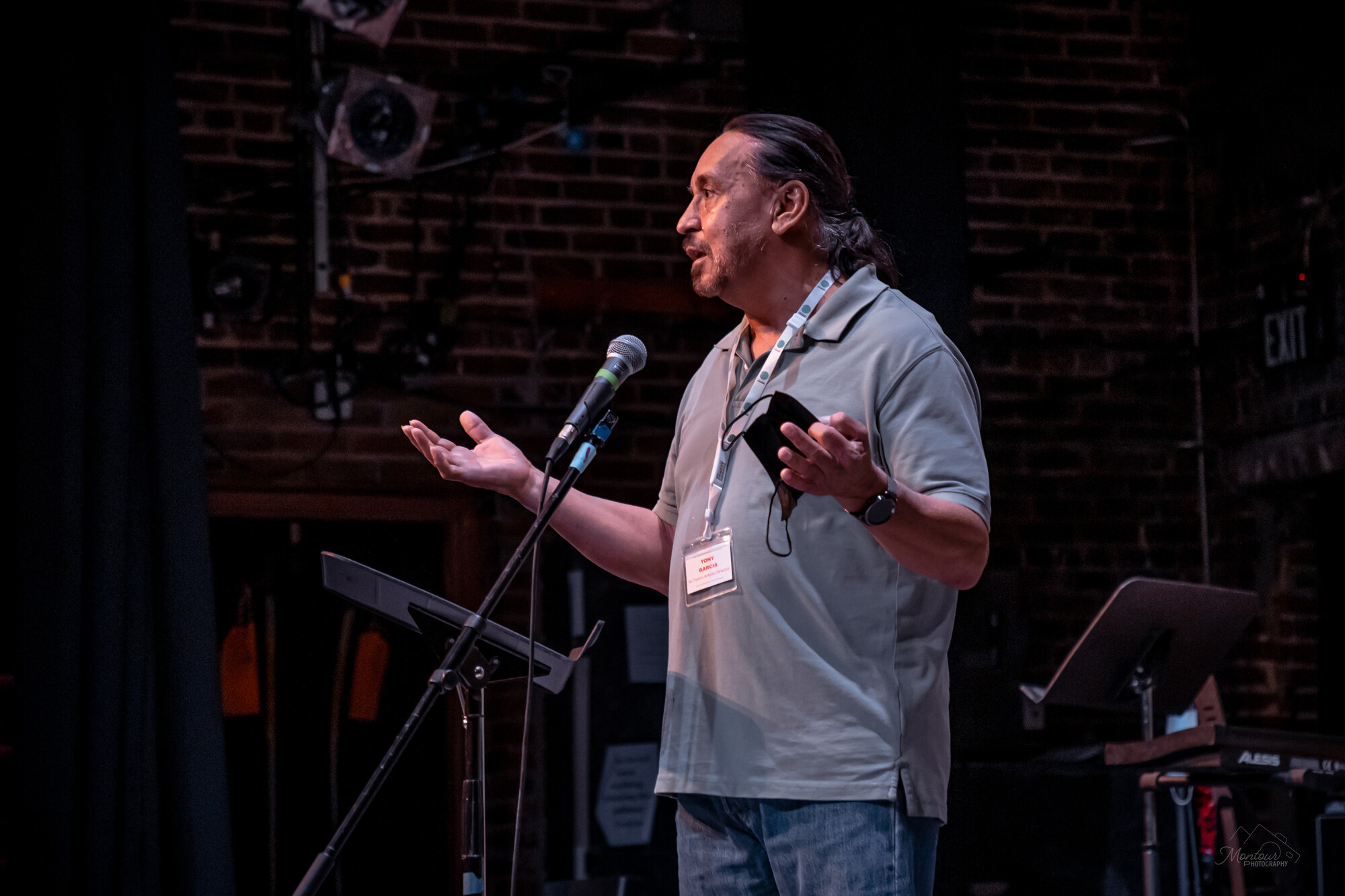
Tony Garcia at the opening ceremony of the 2022 Latinx Theatre Commons Comedy Carnaval, hosted by Su Teatro.
Tony: Organizations that have had stability in their facilities and own property have been successful in achieving long-term sustainability.
So why did you do theatre?
Claudia: My parents grew up really poor and without access to arts. My mom, in particular, wasn’t allowed to do anything. It was like, “You’re going to be a wife and a mother.” And when she had me and my sister, they basically just signed us up for everything possible because they were like, “Let’s give them the opportunities that we didn’t have.”
In high school, I was like, “I know I want to go into civic leadership, or leadership, or the arts.” I decided to study acting at a BFA program. I finally said, “This is what I’m doing.” I joke with my dad, who is a minister in Houston, that we essentially have the same job. He tells his stories and brings people together in a ritualistic setting to be inspired. We’re doing the same thing, and it serves the same purpose in our community.
Tony: I found a parallel in your story about the minister. I grew up Catholic. I remember sitting in the Mass thinking, “This would be so much better if the priest moved over here and music came in here.” And I didn’t realize it until later that I wanted to direct the Mass.
I became interested in theatre when I saw El Teatro Campesino perform. I was 19. La Carpa de Los Rasquachis one of the best works of theatre I’ve ever seen. The play began with the crucifixion and Christ speaking in Mayan. Luis Valdez at his metaphysical best. I thought, “Wow, they are mixing myth, metaphor, and spirituality all together and the play just started.” Everything that you’re talking about that you saw in the church was on that stage, and it was our people doing it.
We didn’t intend to upend the entire system, but we ended up producing a lot of artists who continued building that movement.
Claudia: I can only imagine what it was like coming from the Chicano theatre movement and being among all those people who connected theatre to activism.
The first time I ever saw that plays were even written by Latine people was in high school in our library. I was looking for monologues in the play section, and I saw Josefina Lopez’s name on the spine. I pulled it out. It was Real Women. I was just like, “What? Nobody told me this was a thing, that my people created plays too.” It was still years before I saw a show that was Chicano or Latine.
Tony: About twenty-something years ago, I wrote a piece called Papi, Me, and Cesar Chávez. I got the idea to do it because I was talking to some kids and they knew who Julio Cesar Chávez was, but they didn’t know who Cesar was.
Su Teatro performed in the streets because we weren’t allowed in the theatres. Our artists created murals on the walls because we weren’t allowed in the museums.
We went to the TENAZ Festival in 1974, in Mexico City. Weirdly enough, we opened for El Teatro Campesino. In 1975, El Teatro Campesino came to Denver on tour, and they stayed with us. For two weeks we got this intensive Teatro experience. It reinforced what we were doing. One night, I’m sitting in the back of the theatre watching La Carpa. People in the audience are crying, and I’m watching all the tough pachucos wiping their eyes. I was like, “Shit, that’s a lot of power to make these guys cry.”
We didn’t intend to upend the entire system, but we ended up producing a lot of artists who continued building that movement. Cesar Chávez says that it doesn’t matter how you came to the movement, all that matters is that you did. Everyone’s route to get there is different, but it doesn’t matter. And Corky Gonzales says, “Once you reach consciousness, you can never go backwards.”
And at some point, I realized that I wasn’t happy doing anything else besides teatro. I wanted to be in the movement. I wanted to make social change.
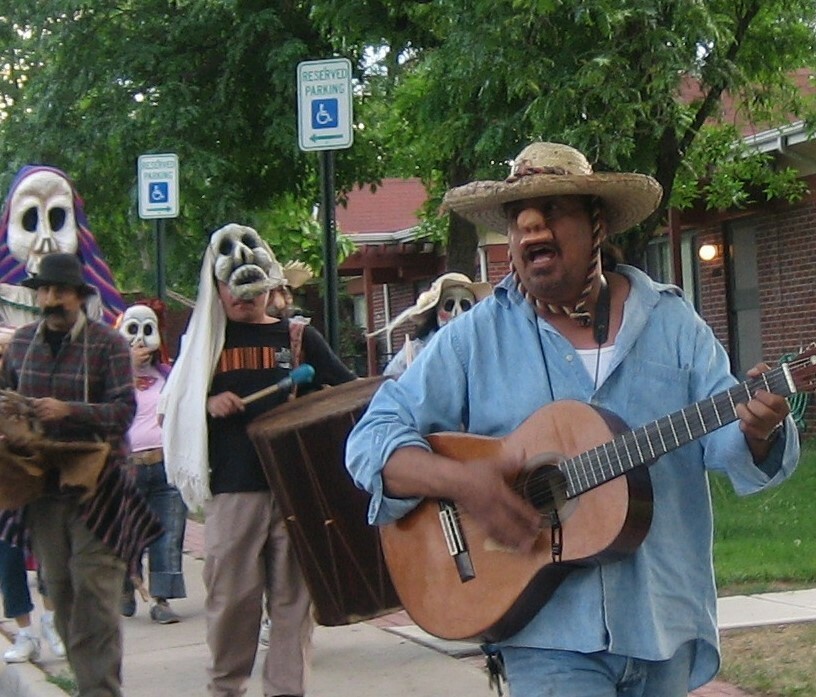
Tony Garcia as part of a Banda Calavera in 2012, leading a performance through the Columbine Homes for a performance at Valverde Park.
Claudia: Along the way, did you have mentors?
Tony: I was fortunate to interact with Luis over the years, but I got to be real tight with his musician/composer brother, Daniel Valdez. Rudolfo Anaya also really encouraged me and criticized me when he didn’t think I was doing the right thing. At the TENAZ Festival in ’75, we connected with Puerto Rican performers like Pregones, and since that time, they’ve been really great partners.
How about you?
Claudia: There are people along my path that I realize, looking back, even if they weren’t aware that they were mentoring me, or maybe I was too immature to acknowledge it, they were my inspirations and served as models for me.
One of the people is Mark Valdez, artistic director of MixedBlood, one of the first directors I worked with out of acting school. It inspired me to see a professional Latino director who was smart, successful, and creative. Watching him showed me it was possible to be someone who straddles the world of both Latine and non-culturally specific work.
The other one is Josefina Lopez. Her experience as a woman who comes from Chicanx theatre and who was—and still is—fighting her way through Hollywood really had an impact on me. Seeing how she led and how she connected the work to her spiritual purpose, seeing what she’s done with CASA 0101 in Boyle Heights, and how she continues to be a businesswoman… I don’t think I’ve told her enough that’s what she represented to me.
Tony: It appears you had good mentors also.
Circling back to how Su Teatro and the mainstream arts scene get along… A lot of the regional theatres have wanted to bring the two coasts to the middle of the country. I don’t think that’s what regional theatre should do. It should be expressing what is happening in their region and serve as an interconnection, bringing things together and moving them out. Only recently have they started to do that. The reality is they don’t have those relationships and they don’t know how to do it.
During COVID, we saw how difficult it was for the regionals to move into that space. They laid off tons of staff. Really showing how they connected with their community. We busted our asses and laid off none. We were a smaller boat that was able to navigate, and the big Titanics struggled. People like you have the power—the possibility of being able to really change that arc completely. It might be the work of another generation.
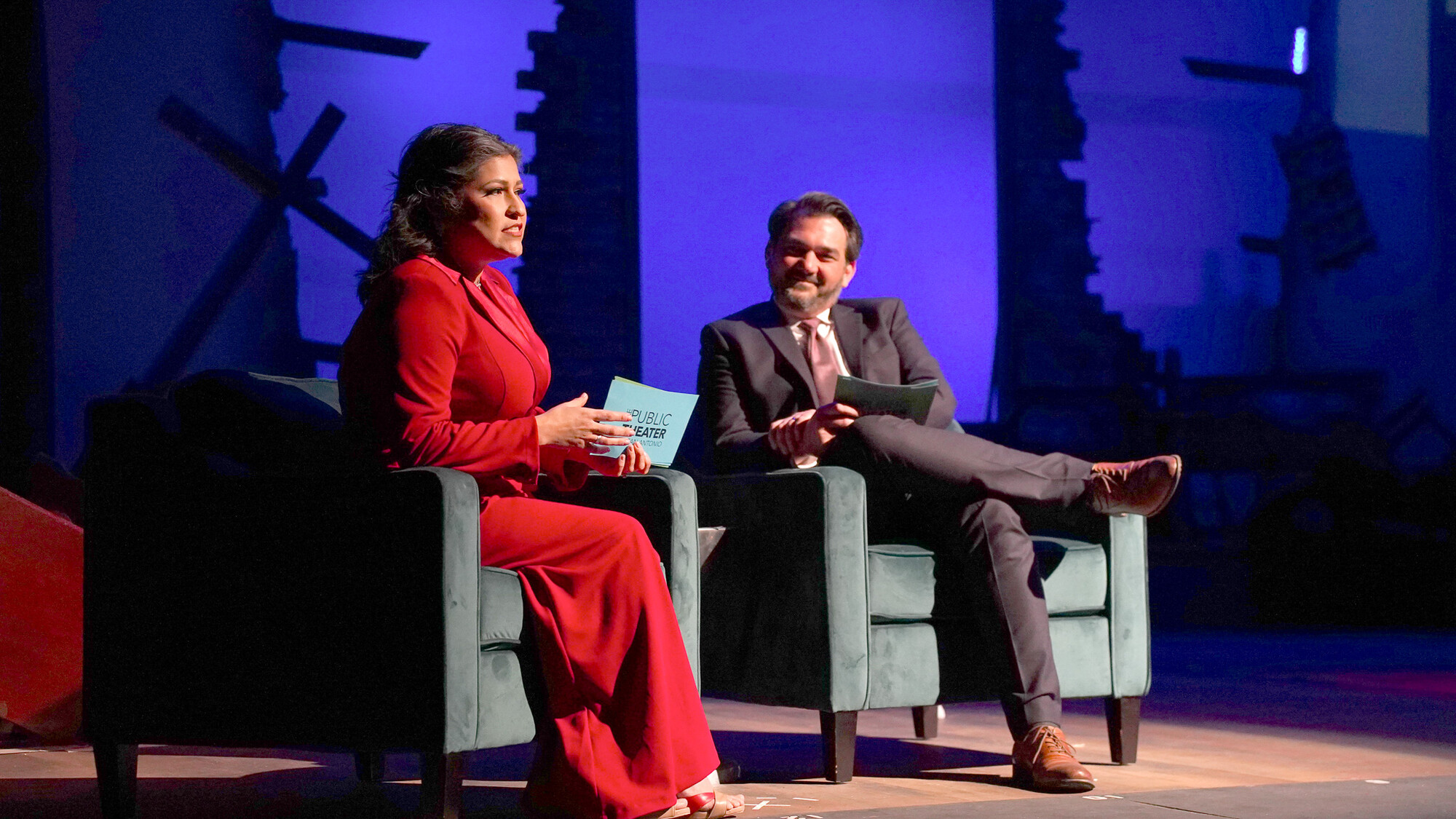
Former executive artistic director Claudia de Vasco in conversation with Magik Theatre artistic director Anthony Runfola at the Public Theater of San Antonio in January 2023. Presented on the set of Nina Simone: Four Women by Christina Ham, directed by Ann James. Set design by James. V. Thomas. Lighting design by Carlos R. Nine. Photo by Luis Vasquez.
Claudia: That’s one of the reasons I accepted this job. I thought, well, I know what needs to happen in American theatre, or what I think it needs to happen is a recentering; that it has to be jostled around and made so that our work is just as universal as the other “mainstream” work.
It excited me to take over a predominantly white theatre in a city that was majority Latine because I was like, “If there’s any city where already the core culture is Mexican American, then how is the theatre, the, longest-running theatre in town, not already centering the Latine experience.” I thought, “Maybe this is a bridge. This is a way to show what’s possible.” I know that’s a big task, and I’m not trying to pretend I can fix American theatre alone.
What I didn’t expect is that in a city that was majority Latine, it is still so prejudiced and segregated. On the surface our culture is celebrated as the character of the city, but underneath it’s not really welcomed in an actual position of power. Never in the history of our theatre in San Antonio had there been a play written by a Latine playwright or a play centering Mexican American culture until this fall, when we produced American Mariachi by Jose Cruz Gonzalez.
So now, I’m really working on trying to re-center the theatre. We’re going to reach out to all those people who have never been welcomed into our theatre that live in South side, West side, San Antonio. We’re still going to also offer programming inclusive of everyone. But our community has often lacked the resources other communities have been getting. There’s a lot of development training, resource sharing, resource providing that I don’t think predominantly white institutions are having to even think about. I keep telling that to our city leaders: “We’re making these changes, but it’s going to take more resources and more support.” Because it’s not as easy as just picking a Mexican American play.
If we’re really saying we want to bring in all these communities we’ve been ignoring, which is essentially the Latine community, how are we adjusting access, considering factors such as terms of pricing and accessibility?
Tony: You were talking about American Mariachi—American Mariachi was powerful. I saw white people in the audience crying. Our plays will always benefit from more productions. It really is having people like you being in power.
You deal with people who don’t think you belong. I had a meeting with the head of the art department at Colorado University because we were doing production there. I walked into the dean’s office and, without looking up, the secretary handed me keys and she said, “The mop and the broom are over there.” And I said, “That’s cool, except I’m here to see the dean. But if I need them, I know where they are.”
We’ve always had that. Now it manifests itself differently. The universities aren’t bringing us in to work with their theatre departments. The theatre profs bring what they got touched with in college and look for those who can present through their lens and the approved canon. We are having to expose them to a broader palette.
I don’t think it’s all about programming, though. I think it really is about nurturing that new audience, that other generation, by being on the ground and working. I’m never going to make my nut selling tickets at twenty bucks a piece. But if I do my tickets at forty, forty-five bucks, they ain’t going to come. That’s another piece of this stuff of the formula. Our tickets are going to have to be underwritten.
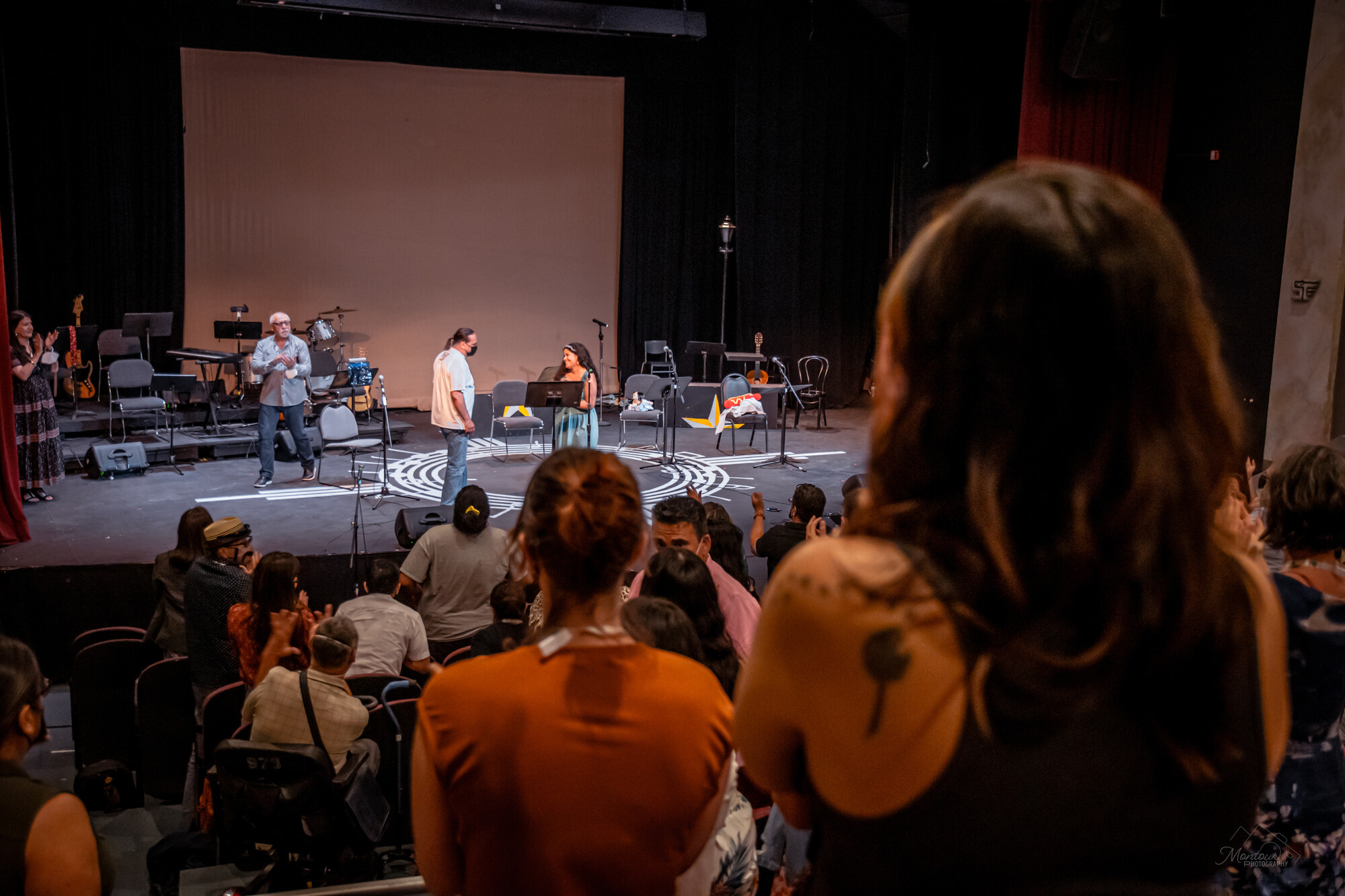
Tony Garcia receiving an award from the Latinx Theatre Commons for 50 years of service to the Latinx and Chicano community.
Claudia: I’m trying to explore these new models. If we’re really saying we want to bring in all these communities we’ve been ignoring, which is essentially the Latine community, how are we adjusting access, considering factors such as terms of pricing and accessibility? What I love about these conversations is there’s no way around it other than through it. And we have to do it however incrementally our impact is, like you and the Chicano Movement.
What do you want to be remembered for?
Tony: I don’t have a big concern or interest in what people will say. I’m more concerned about making cracks in the system.
I think what I’d like is to have young people still be on our stages, those stories continuing to be told. I would like to see people breaking whatever norms are being placed in their way, and people being obnoxious and making mistakes. I think mistakes are the most important thing in a learning process. One of the biggest things we can do in theatre is give people and audiences places to make mistakes and to learn from that process.
What do you want to be remembered for?
Claudia: I have thought a lot about it. When I took this job I was like, “I don’t know how long this will last, but I hope to make enough of an impact while I am able.” When I think about what I hope to be remembered for, it’s that I was part of the fabric and movement of leaders and theatre workers across the country who were working to decenter, decolonize, and change the American theatre.
Tony: And you are. Every day. That arc is really, really long.

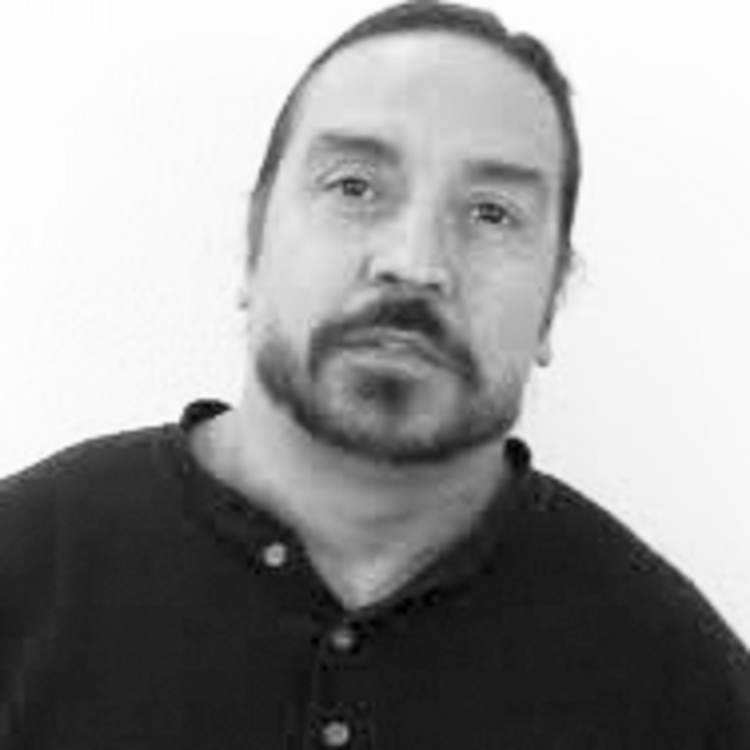
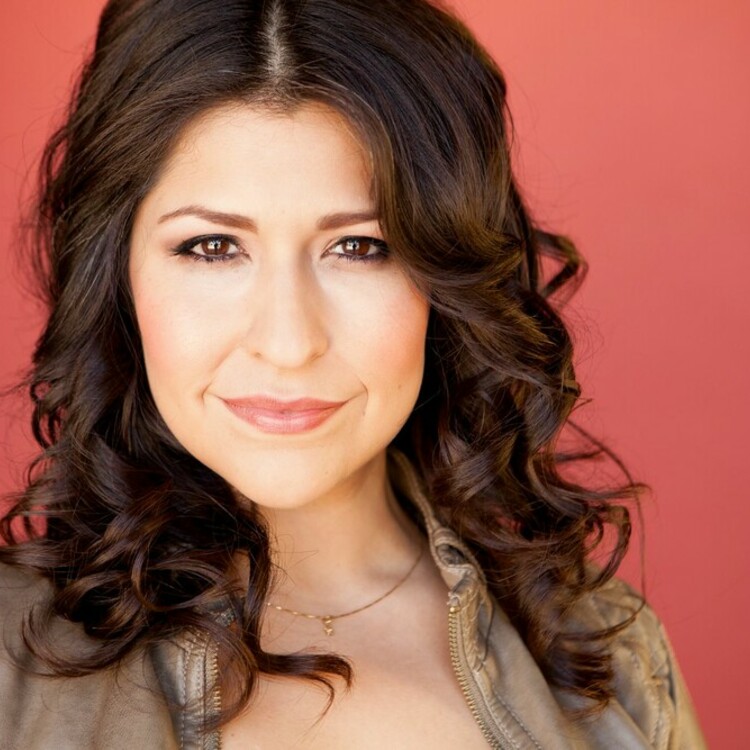


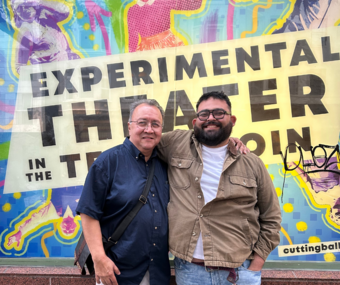





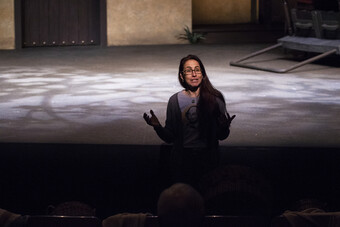


Comments
The article is just the start of the conversation—we want to know what you think about this subject, too! HowlRound is a space for knowledge-sharing, and we welcome spirited, thoughtful, and on-topic dialogue. Find our full comments policy here